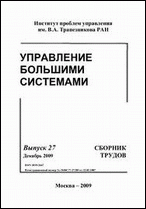|
Control in Social and Economic Systems
Influence of changing threshold values of proximity index of party’s positions on the measure of the balancedness of the reichstag of the weimar republic
D. Tkachev
International Center of Decision Choice and Analysis, HSE, Moscow
Abstract:
In this research we study 8 convocations of the Weimar Reichstag between 1920 and 1933. For each convocation we construct models, describing all possible coalitions in the Reichstag. The ideology of each party can be identified by their position on the “left/right” scale. Parties of the Reichstag are prescribed the index from 1 to 10 depending on their position on this scale. The index of left parties is close to 1, whereas the index of right parties is close to 10. To evaluate two parties can coalesce we calculate the distance of these parties’ positions on the “left/right” scale, that is equal to the index difference. It is assumed that the high distance of two parties means the impossibility to coalesce. Several models of coalition formation are constructed on the threshold value of positions distance. A parliament is called balanced if it consists of two coalitions. We evaluate the measure of the balancedness, which shows the degree of proximity to the total balanced parliament. We use two different methods to calculate the measure of the balancedness. First one includes all possible coalitions in the Reichstag. The second measure includes only coalitions in which the number of votes is greater than the established quota of the Reichstag convocation. For each model we evaluate the measure of the balancedness using both methods.
Keywords:
balance of the parliament, Reichstag, parliament’s model, signed graph, measure of the balancedness.
Received: September 3, 2020
Published: November 30, 2020
Citation:
D. Tkachev, “Influence of changing threshold values of proximity index of party’s positions on the measure of the balancedness of the reichstag of the weimar republic”, UBS, 88 (2020), 124–155
Linking options:
https://www.mathnet.ru/eng/ubs1066 https://www.mathnet.ru/eng/ubs/v88/p124
|

| Statistics & downloads: |
| Abstract page: | 68 | | Full-text PDF : | 51 | | References: | 14 |
|




 Contact us:
Contact us: Terms of Use
Terms of Use
 Registration to the website
Registration to the website Logotypes
Logotypes







 Citation in format
Citation in format 